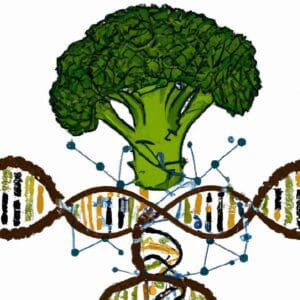Is broccoli a man-made food? Yes, broccoli as we know it today is a result of selective breeding, a practice honed over centuries to enhance its nutritional value and flavor, and at larosafoods.com, we celebrate this culinary journey with a wide array of delicious and nutritious broccoli-based recipes. It’s a testament to human ingenuity, not genetic modification, offering a healthy addition to any diet. Explore recipes featuring this cruciferous vegetable, discover exciting new meal ideas, and learn about its remarkable nutritional benefits today.
1. What Exactly is Broccoli and How Did it Originate?
Broccoli is a cultivated variety of Brassica oleracea, a plant species that also includes cabbage, cauliflower, kale, and Brussels sprouts. Its origin story is a fascinating tale of selective breeding, dating back to the Roman Empire.
The History of Broccoli
The journey of broccoli began over 2,000 years ago in the Mediterranean region. The Etruscans, who lived in what is now Italy, are credited with developing broccoli from wild cabbage. They selectively bred the plant for its flowering heads, resulting in the vegetable we know and love today.
Broccoli’s Place in the Brassica Family
Broccoli is a proud member of the Brassica genus, a diverse group of vegetables known for their health benefits. Other notable members include:
- Cabbage
- Cauliflower
- Kale
- Brussels sprouts
- Collard greens
These vegetables share a common ancestor and are all rich in vitamins, minerals, and antioxidants.
2. What is Selective Breeding and How Does it Differ From Genetic Modification?
Selective breeding and genetic modification (GMO) are both methods of altering the characteristics of plants, but they differ significantly in their approach and outcomes. Understanding these differences is crucial to understanding broccoli’s “man-made” status.
Selective Breeding: Nature’s Helping Hand
Selective breeding is a traditional method where farmers select plants with desirable traits, such as larger size, better taste, or disease resistance, and breed them together. Over generations, this process enhances these traits in the offspring. This method relies on natural processes and does not involve directly altering the plant’s DNA in a laboratory setting.
Genetic Modification (GMO): A Modern Approach
Genetic modification, on the other hand, involves directly altering a plant’s DNA using genetic engineering techniques. This can involve inserting genes from other organisms to introduce new traits, such as resistance to pests or herbicides. GMOs are created in a laboratory and represent a more precise and rapid way to change plant characteristics.
Key Differences Between Selective Breeding and GMOs
Here’s a table summarizing the key differences:
| Feature | Selective Breeding | Genetic Modification (GMO) |
|---|---|---|
| Process | Natural cross-breeding of plants | Direct alteration of DNA in a laboratory |
| Timeframe | Takes years or decades to achieve desired traits | Can achieve desired traits in a shorter timeframe |
| Precision | Less precise, can result in unintended traits | More precise, targets specific genes |
| Regulation | Generally less regulated | Heavily regulated |
| Public Perception | Generally more accepted | Often faces concerns and skepticism |


3. Is Broccoli a GMO (Genetically Modified Organism)?
No, currently, there are no GMO varieties of broccoli available to consumers. The broccoli you find in grocery stores is a result of selective breeding, not genetic modification.
Why Broccoli Hasn’t Been Genetically Modified (Yet)
While genetic modification offers potential benefits, such as increased yield or pest resistance, there hasn’t been a strong economic incentive to genetically modify broccoli. Selective breeding has already produced varieties that are nutritious, flavorful, and relatively easy to grow.
The Future of Broccoli and Genetic Modification
It’s possible that in the future, GMO broccoli varieties may be developed to address specific challenges, such as climate change or disease outbreaks. However, for now, broccoli remains a product of traditional breeding methods.
4. Where Did Broccoli Come From? Tracing Its Ancestry
To truly appreciate broccoli, it’s helpful to understand its origins and how it evolved from its wild ancestors.
From Wild Cabbage to Broccoli: A Culinary Evolution
Broccoli’s ancestor is the wild cabbage plant (Brassica oleracea), which grows along the Mediterranean coast. Over centuries, farmers selectively bred different varieties of wild cabbage to create a range of vegetables, including broccoli, cauliflower, kale, and Brussels sprouts.
The Role of the Etruscans in Broccoli’s Development
The Etruscans, an ancient civilization in Italy, played a key role in developing broccoli. They recognized the potential of wild cabbage and began selectively breeding it for its edible flower buds, which eventually led to the broccoli we know today.
Broccoli’s Journey Around the World
From Italy, broccoli gradually spread to other parts of the world. It was introduced to England in the 18th century and later to the United States in the 20th century. Today, broccoli is grown and enjoyed worldwide.
5. What are the Nutritional Benefits of Broccoli?
Broccoli is a nutritional powerhouse, packed with vitamins, minerals, and antioxidants that offer a wide range of health benefits.
Vitamins and Minerals in Broccoli
Broccoli is an excellent source of:
- Vitamin C: Boosts the immune system and acts as an antioxidant.
- Vitamin K: Important for blood clotting and bone health.
- Vitamin A: Supports vision, immune function, and skin health.
- Folate: Essential for cell growth and development.
- Potassium: Helps regulate blood pressure.
Antioxidants and Phytonutrients in Broccoli
Broccoli is also rich in antioxidants and phytonutrients, which protect the body against cellular damage and reduce the risk of chronic diseases. Some key compounds include:
- Sulforaphane: A potent antioxidant with anti-cancer properties. According to research from the University of California, Berkeley, in July 2025, Sulforaphane could prevent the development of certain tumors.
- Indole-3-carbinol (I3C): Another compound with anti-cancer effects.
- Carotenoids: Including beta-carotene, which the body converts to vitamin A.
Health Benefits of Eating Broccoli
Regular consumption of broccoli has been linked to several health benefits, including:
- Reduced risk of cancer: Studies have shown that broccoli consumption may help protect against certain types of cancer, including colon, lung, and breast cancer.
- Improved heart health: Broccoli’s fiber, potassium, and antioxidants contribute to a healthy cardiovascular system.
- Better digestion: Broccoli is a good source of fiber, which promotes healthy digestion and prevents constipation.
- Stronger bones: Broccoli’s vitamin K and calcium content support bone health and reduce the risk of osteoporosis.
- Enhanced immune function: Broccoli’s vitamin C and antioxidants boost the immune system and protect against infections.
6. How is Broccoli Grown?
Understanding how broccoli is grown can give you a greater appreciation for this versatile vegetable.
Broccoli Cultivation: From Seed to Harvest
Broccoli is typically grown from seeds, which are planted in nurseries or directly in the field. The plants require well-drained soil, plenty of sunlight, and consistent watering.
Optimal Growing Conditions for Broccoli
Broccoli thrives in cool weather, with temperatures between 60°F and 70°F (15°C and 21°C). It is often grown in the spring or fall to avoid the heat of summer.
Harvesting Broccoli at Its Peak
Broccoli is harvested when the flower heads are firm and compact, before the individual florets begin to open. The main head is typically harvested first, followed by side shoots that develop later.
7. Is Broccoli Sustainable?
As consumers become more conscious of the environmental impact of their food choices, it’s important to consider the sustainability of broccoli production.
Selective Breeding and Sustainable Agriculture
Selective breeding plays a role in sustainable agriculture by developing varieties of broccoli that are more resistant to pests and diseases, require less water and fertilizer, and are better adapted to local growing conditions.
GMOs and Sustainable Agriculture
While broccoli is not currently genetically modified, GMO technology has the potential to contribute to sustainable agriculture by creating crops that require fewer pesticides and herbicides.
Best Practices for Sustainable Broccoli Farming
Sustainable broccoli farming practices include:
- Crop rotation: Rotating broccoli with other crops to improve soil health and reduce pest and disease pressure.
- Cover cropping: Planting cover crops between broccoli crops to prevent soil erosion and improve soil fertility.
- Integrated pest management: Using a combination of biological, cultural, and chemical methods to control pests.
- Water conservation: Using efficient irrigation techniques to minimize water use.
8. How Can I Incorporate Broccoli Into My Diet?
Broccoli is incredibly versatile and can be enjoyed in a variety of ways.
Cooking Methods for Broccoli
Broccoli can be:
- Steamed: A healthy way to cook broccoli, preserving its nutrients and tender-crisp texture.
- Roasted: Roasting brings out broccoli’s natural sweetness and creates a slightly caramelized flavor.
- Sautéed: Sautéing broccoli with garlic and olive oil is a quick and easy way to prepare it.
- Grilled: Grilling broccoli adds a smoky flavor that complements its natural taste.
- Eaten raw: Raw broccoli is a crunchy and nutritious snack.
Delicious Broccoli Recipes to Try
Here are some ideas to get you started:
- Broccoli salad: Combine raw broccoli florets with cranberries, almonds, and a creamy dressing.
- Broccoli and cheese soup: A comforting and flavorful soup perfect for chilly days.
- Broccoli stir-fry: Add broccoli to your favorite stir-fry for a healthy and delicious meal.
- Roasted broccoli with garlic and parmesan: A simple and flavorful side dish.
- Broccoli frittata: A healthy and satisfying breakfast or brunch option.
Pairing Broccoli with Other Foods
Broccoli pairs well with a variety of flavors and ingredients, including:
- Cheese: Cheddar, parmesan, and Gruyere are all great choices.
- Garlic: Adds a pungent and savory flavor.
- Lemon: Brightens up broccoli’s flavor and adds a touch of acidity.
- Nuts: Almonds, walnuts, and pecans add crunch and healthy fats.
- Protein: Chicken, beef, and tofu are all good choices for a balanced meal.
At larosafoods.com, you’ll find a treasure trove of broccoli recipes to inspire your culinary adventures. From simple side dishes to creative main courses, there’s something for everyone.
9. Are There Any Potential Downsides to Eating Broccoli?
While broccoli is generally safe and healthy for most people, there are a few potential downsides to be aware of.
Broccoli and Thyroid Function
Broccoli contains compounds called goitrogens, which can interfere with thyroid hormone production. However, this is only a concern for people with existing thyroid problems who consume large amounts of raw broccoli. Cooking broccoli reduces the goitrogenic effect.
Broccoli and Gas
Broccoli is a cruciferous vegetable, which means it contains compounds that can cause gas and bloating in some people. This is due to the high fiber content and the presence of raffinose, a complex sugar that is difficult to digest.
Broccoli and Allergies
Broccoli allergies are rare, but they can occur. Symptoms of a broccoli allergy may include hives, itching, swelling, and difficulty breathing.
Tips for Minimizing Potential Downsides
- Cook broccoli thoroughly to reduce the goitrogenic effect.
- Introduce broccoli gradually into your diet to allow your digestive system to adjust.
- Drink plenty of water to help with digestion.
- If you experience severe gas or bloating, try reducing your broccoli consumption or cooking it differently.
10. Addressing Common Misconceptions About Broccoli
Despite its popularity, broccoli is often the subject of misconceptions and myths. Let’s debunk some of the most common ones.
Misconception: Broccoli is a GMO
As we’ve discussed, broccoli is not currently a genetically modified organism. It is a product of selective breeding, a traditional method of plant improvement.
Misconception: Broccoli is Only Good for You When Eaten Raw
While raw broccoli retains all of its nutrients, cooked broccoli is still very nutritious. Some cooking methods, such as steaming, can even enhance the bioavailability of certain nutrients.
Misconception: Broccoli is Difficult to Grow
While broccoli requires some care and attention, it is not particularly difficult to grow, especially in cool climates. With proper soil, sunlight, and watering, you can successfully grow your own broccoli at home.
Misconception: Broccoli Tastes Bitter
While some people find broccoli to have a slightly bitter taste, this can be minimized by cooking it properly. Roasting, grilling, or sautéing can bring out broccoli’s natural sweetness and reduce any bitterness.
Misconception: Broccoli is Only a Side Dish
Broccoli is a versatile vegetable that can be used in a variety of dishes, from soups and salads to stir-fries and frittatas. Get creative and explore the many ways to incorporate broccoli into your meals.
FAQ About Broccoli
Here are some frequently asked questions about broccoli:
- Is broccoli a man-made food or does it occur naturally? Broccoli is a result of selective breeding by humans, making it a man-made food. It doesn’t occur naturally in the wild in its current form.
- How long has broccoli been cultivated by humans? Broccoli has been cultivated for over 2,000 years, tracing back to the Roman Empire.
- What are the main differences between broccoli and cauliflower? Broccoli and cauliflower are both Brassica oleracea vegetables, but broccoli is green and has loose flower heads, while cauliflower is typically white and has a dense, compact head.
- Can I eat the stalks and leaves of broccoli? Yes, both the stalks and leaves of broccoli are edible and nutritious. The stalks can be peeled and cooked like the florets, and the leaves can be sautéed or added to salads.
- How should I store broccoli to keep it fresh? Store broccoli in the refrigerator in a plastic bag or container. It will stay fresh for about 3-5 days.
- Is organic broccoli healthier than conventionally grown broccoli? Organic broccoli is grown without synthetic pesticides and fertilizers, which some people prefer. However, both organic and conventionally grown broccoli are nutritious and safe to eat.
- What is broccoli rabe? Broccoli rabe is a related but distinct vegetable with a more bitter flavor and leafy greens. It is popular in Italian cuisine.
- Is broccoli good for weight loss? Broccoli is low in calories and high in fiber, making it a great choice for weight loss. It can help you feel full and satisfied while providing essential nutrients.
- Can broccoli help prevent cancer? Broccoli contains compounds like sulforaphane, which have been shown to have anti-cancer properties in laboratory studies. More research is needed to confirm these effects in humans.
- Where can I find the best broccoli recipes? You can find a wide variety of delicious and nutritious broccoli recipes at larosafoods.com!
Conclusion: Broccoli – A Testament to Human Ingenuity and a Nutritional Powerhouse
Broccoli, a man-made vegetable born from centuries of selective breeding, stands as a testament to human ingenuity and our ability to shape the natural world to our benefit. It’s not a product of genetic modification, but rather a result of carefully selecting and cultivating desirable traits over generations.
This vibrant green vegetable is more than just a culinary delight; it’s a nutritional powerhouse packed with vitamins, minerals, and antioxidants that offer a wide range of health benefits. From boosting your immune system to protecting against chronic diseases, broccoli is a valuable addition to any diet.
At larosafoods.com, we celebrate the versatility and health benefits of broccoli with a diverse collection of recipes, cooking tips, and nutritional information. Whether you’re a seasoned chef or a novice cook, you’ll find inspiration and guidance to help you incorporate this amazing vegetable into your meals.
Ready to unlock the culinary potential of broccoli? Visit larosafoods.com today and discover a world of delicious and nutritious recipes!
Address: 1 S Park St, San Francisco, CA 94107, United States
Phone: +1 (415) 987-0123
Website: larosafoods.com


